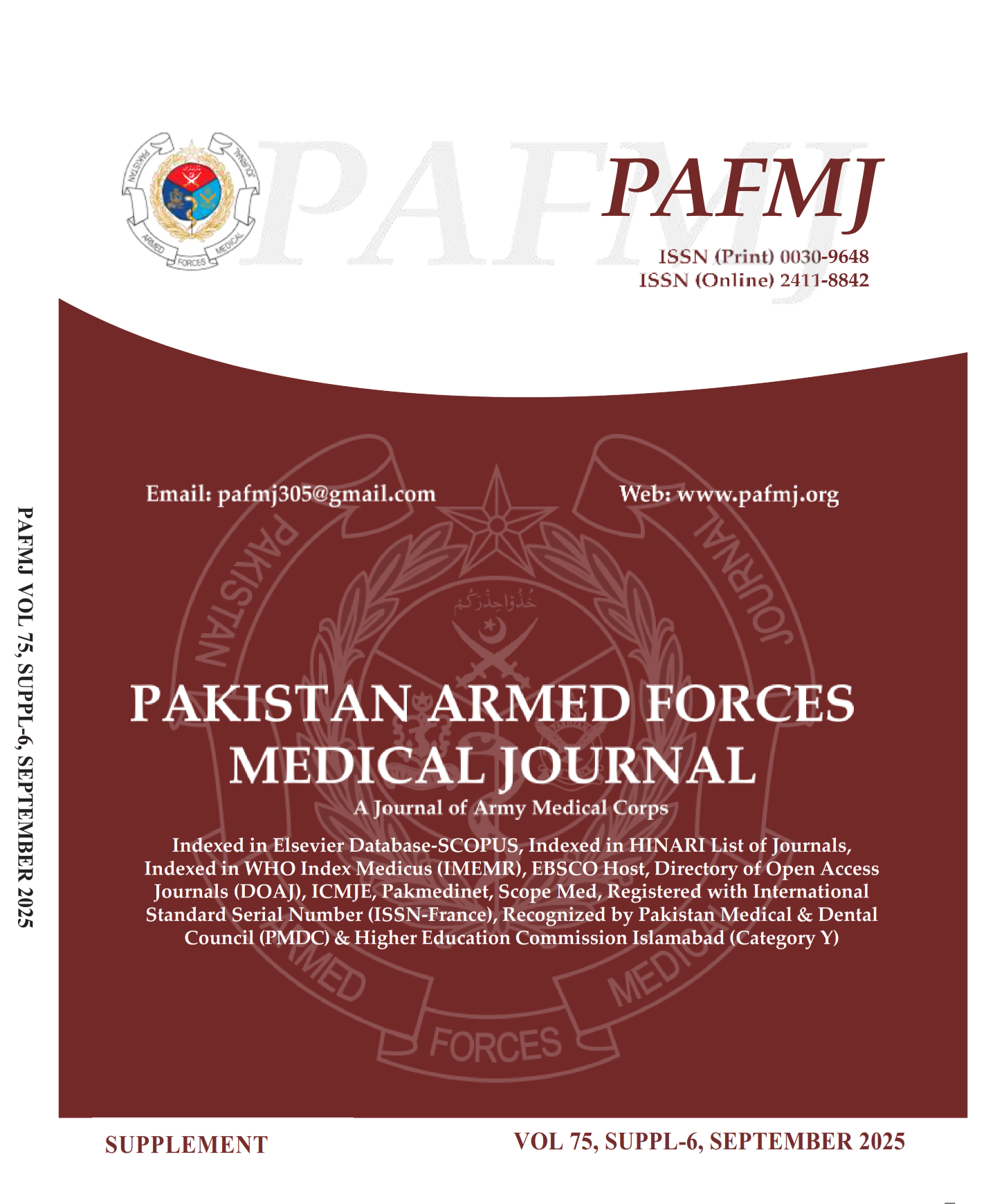Initial Clinical Presentation and Laboratory Parameters of Indoor Hiv-Positive Patients
DOI:
https://doi.org/10.51253/pafmj.v75iSUPPL-6.8198Keywords:
Clinical profile; HIV; laboratory investigationsAbstract
Objective: To determine the pattern of the clinical presentation and laboratory parameters and factors associated with low CD-4 count among the patients hospitalized for initial presentation of human immune deficiency virus (HIV) in Pak Emirates Military Hospital.
Study Design: Case series
Place and Duration of Study: Pak Emirates Military Hospital Rawalpindi. From January 2019 to January 2020.
Methodology: A total of 60 cases were included in this study in liaison with other departments where the patients with initial presentation of HIV were admitted. Patients without any past history of HIV and diagnosed first time in current presentation by ELISA were included. Routine investigations along with CD-4 count and viral load were performed. Patients were screened for all the diseases and clinical conditions associated with HIV.
Results: Mean age of study participants was 39.4±4.81 years. 55 (91.7%) were males while 05(8.3%) were females. Thirty-nine (65.0%) patients had CD-4 count within range while 21(35.0%) had low CD-4 counts. Thirty-six (60.0%) had viral load in range while 24(40.0%) had high viral load. Chronic diarrhea was the commonest condition in our study sample followed by tuberculosis. Pearson chi-square analysis revealed that high viral load and presence of more than HIV related diseases were the factors strongly linked with the presence low CD-4 count among the HIV patients at their initial presentation.
Conclusion: Considerable number of patients presented with low CD 4 counts and high viral load at the initial presentation. Similarly, high number of patients had more than one HIV related clinical .......
Downloads
References
1. Phanuphak N, Gulick RM. HIV treatment and prevention 2019: current standards of care. Curr Opin HIV AIDS. 2020; 15(1): 4-12. https://doi: 10.1097/COH.0000000000000588.
2. Kempton J, Hill A, Levi JA, Heath K, Pozniak A. Most new HIV infections, vertical transmissions and AIDS-related deaths occur in lower-prevalence countries. J Virus Erad. 2019; 5(2): 92–101. Published 2019 Apr 1.
3. Khan MD, Wali A, Fatima R, Yaqoob A, Aziz S. Prevalence and associated risk factors of HIV in prisons in Balochistan, Pakistan: a cross-sectional study. F1000Res. 2018; 7: 1821. Published 2018 Nov 20. https://doi:10.12688/f1000research.16994.2
4. GBD 2015 HIV Collaborators. Estimates of global, regional, and national incidence, prevalence, and mortality of HIV, 1980-2015: the Global Burden of Disease Study 2015 [published correction appears in Lancet HIV. 2016 Sep; 3(9): e408]. Lancet HIV. 2016; 3(8): e361–e387.
https://doi:10.1016/S2352-3018(16)30087-X
5. Simon V, Ho DD, Abdool Karim Q. HIV/AIDS epidemiology, pathogenesis, prevention, and treatment. Lancet. 2006; 368(9534): 489–504.
https://doi:10.1016/S0140-6736(06)69157-5
6. Benzekri NA, Sambou JF, Ndong S, et al. Prevalence, predictors, and management of advanced HIV disease among individuals initiating ART in Senegal, West Africa. BMC Infect Dis. 2019; 19(1): 261. Published 2019 Mar 15.
https://doi:10.1186/s12879-019-3826-5
7. Miedzinski LJ. Early Clinical Signs and Symptoms of HIV Infection: Delaying progression to AIDS. Can Fam Physician. 1992; 38: 1401–1410.
8. Hoenigl M, Green N, Camacho M, et al. Signs or Symptoms of Acute HIV Infection in a Cohort Undergoing Community-Based Screening. Emerg Infect Dis. 2016; 22(3): 532–534. https://doi:10.3201/eid2203.151607
9. Sütçü M, Acar M, Aktürk H, et al. Clinical Findings of Pediatric HIV Infection in a Tertiary Center in Turkey.Balkan Med J. 2017; 34(3): 239–245. https://doi:10.4274/balkanmedj.2015.1571
10. Green A. HIV epidemic in children in Pakistan raises concern. Lancet.2019 Jun 8; 393(10188): 2288.
https://doi: 10.1016/S0140-6736(19)31330-3.
11. Chetty S, Naidu K. CLINICAL PRESENTATION OF HIV-INFECTED PATIENTS IN A PSYCHIATRIC HOSPITAL IN SOUTH AFRICA. Afr J Infect Dis. 2018; 12(2): 29–36. Published 2018 Jun 18. https://doi:10.21010/ajid.v12i2.5
12. Merchant RH, Oswal JS, Bhagwat RV, Karkare J. Clinical profile of HIV infection. Indian Pediatr.2001; 38(3): 239-46.
13. Govender S, Otwombe K, Essien T, et al. CD4 counts and viral loads of newly diagnosed HIV-infected individuals: implications for treatment as prevention. PLoS One. 2014; 9(3): e90754. Published 2014 Mar 4. https://doi:10.1371/journal.pone.0090754
14. Kumar S., Bano S. Comparison and Analysis of Health Care Delivery Systems: Pakistan versus Bangladesh.J. Hosp. Med. Manag.2017; 3: 1–7. https://doi: 10.4172/2471-9781.100020
15. Bashir S. HIV/AIDS stigma at the workplace: exploratory findings from Pakistan. SAHARA J.2011; 8(3): 156-61.
https://doi: 10.1080/17290376.2011.9724998.
16. Poznansky MC, Coker R, Skinner C, et al. HIV positive patients first presenting with an AIDS defining illness: characteristics and survival [published correction appears in BMJ 1995 Aug 5;311(7001):356]. BMJ. 1995; 311(6998): 156–158.
https://doi:10.1136/bmj.311.6998.156
17. Khanani MR, Somani M, Rehmani SS, Veras NM, Salemi M, Ali SH. The spread of HIV in Pakistan: bridging of the epidemic between populations.PLoS One. 2011; 6(7): e22449.
https://doi:10.1371/journal.pone.0022449
18. Brown T, Peerapatanapokin W. Evolving HIV epidemics: the urgent need to refocus on populations with risk.Curr Opin HIV AIDS. 2019; 14(5): 337–353.
https://doi:10.1097/COH.0000000000000571
Downloads
Published
Issue
Section
License
Copyright (c) 2025 Aimen Sabir, Shazia Nisar, Khalid Mahmood Raja, Ayesha Anwer, Marriam Hussain Awan, Maria Tariq

This work is licensed under a Creative Commons Attribution-NonCommercial 4.0 International License.















